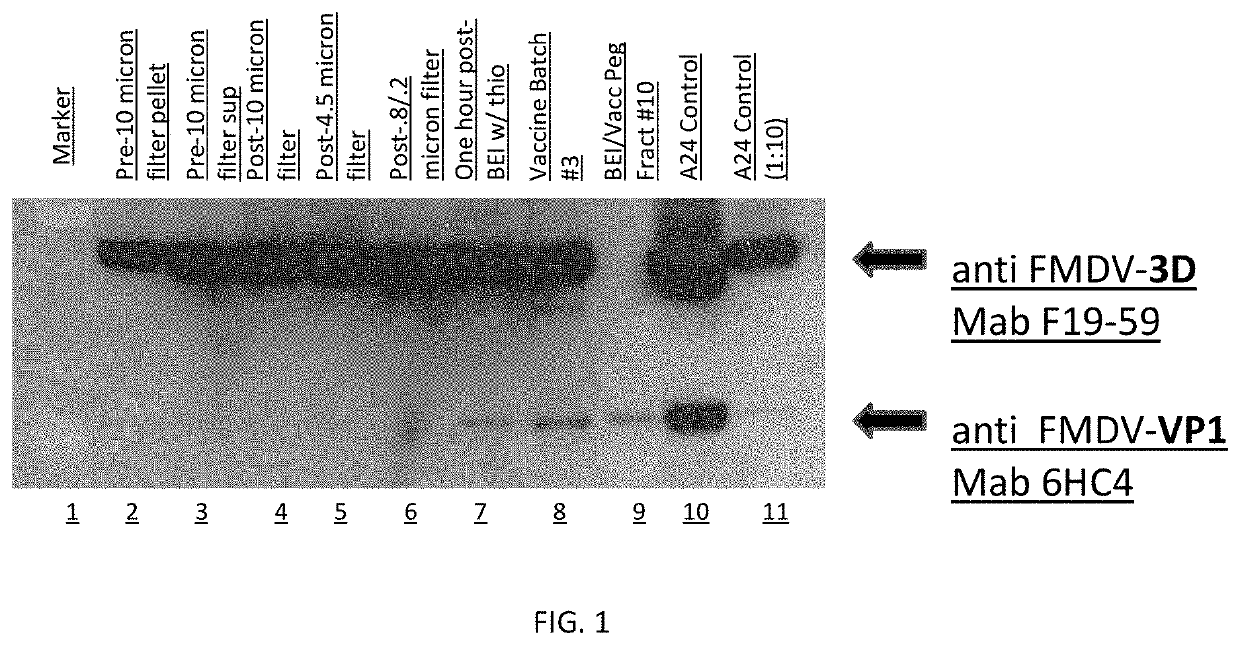Foot-and-mouth disease vaccine
a vaccine and foot and mouth technology, applied in the field of foot and mouth disease vaccine, can solve the problems of difficult to differentiate infected from vaccinated animals (diva) through serological diagnostic tests
- Summary
- Abstract
- Description
- Claims
- Application Information
AI Technical Summary
Benefits of technology
Problems solved by technology
Method used
Image
Examples
example 1
on of Antigens
[0096]Two methods were used to prepare the antigens: Hollow Fiber Filtration and PEG precipitation.
[0097]PEG (poly-ethylene glycol) precipitation methods have been known in the art. Briefly, BHK-21 cells were infected with the FMD virus. Then (24-36 h later) the cells were lysed by freeze-thawing, and cell lysate was clarified of cell debris by low speed centrifugation (500×g). PEG was added (8% w / v) to the supernatant containing both structural and non-structural proteins. The mixture was incubated for 12-18 hr at 4° C. During this incubation, FMDV particles associate with the PEG. Antigen was recovered by centrifugation at 16,000×g and collection of the precipate pellet containing PEG and virus. The supernatant, containing cellular and viral non-structural proteins was discarded. The pellet, to which the virus particles are bound, was then washed with small volumes of buffer to elute the FMDV particles from the PEG.
[0098]An additional method described herein is based...
example 2
f FMD Vaccines Adjuvanted with TXO
Animals and Sample Collection
[0100]Six- to eight-month-old Holstein steers weighing 180-230 kg were used in this study. The animals were free of FMDV-reactive antibodies as determined by 3D ELISA test prior to vaccination as determined later from serum samples taken on Day 0. All 28 animals were commingled in one room in a BSL-3-Ag animal testing facility. The animals were fed complete ration pellets or alfalfa cubes, with water and salt blocks available ad libitum. Animals were acclimatized five days to the facilities prior to Day 0. Animals were previously treated with Bovi-Shield GOLD® 5, Micotil® 300, LiquamycieLA−200° and Dectomax®. Groups of animals (n=4 each) with consecutive ear tag numbers were assigned to a treatment group.
[0101]No adverse events were documented following vaccination.
[0102]Serum separator blood tubes to obtain serum samples were collected at Days 0 (before vaccination), 4, 7, 14, 21 (before challenge), 24, 28, 31 and 42 fr...
PUM
 Login to View More
Login to View More Abstract
Description
Claims
Application Information
 Login to View More
Login to View More - R&D
- Intellectual Property
- Life Sciences
- Materials
- Tech Scout
- Unparalleled Data Quality
- Higher Quality Content
- 60% Fewer Hallucinations
Browse by: Latest US Patents, China's latest patents, Technical Efficacy Thesaurus, Application Domain, Technology Topic, Popular Technical Reports.
© 2025 PatSnap. All rights reserved.Legal|Privacy policy|Modern Slavery Act Transparency Statement|Sitemap|About US| Contact US: help@patsnap.com

